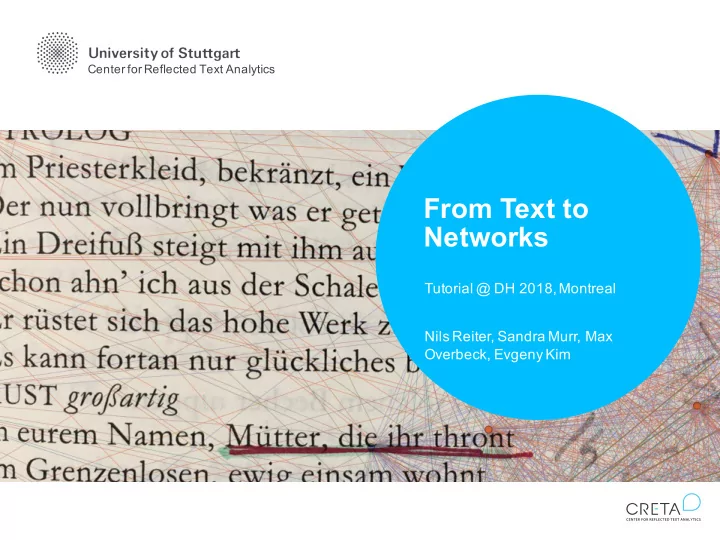

Center for Reflected Text Analytics From Text to Networks Tutorial @ DH 2018, Montreal Nils Reiter, Sandra Murr, Max Overbeck, Evgeny Kim
University of Stuttgart 2
Today’s Goals • Generate networks from raw texts • Nodes represent entity annotations in the text • Edges represent co-occurrence counts • Co-occurrence within a certain text segment • Focus on methods, not tools • Tools serve as an example, but other tools could be used instead • Technical steps are relatively simple • Possible for “early-career” programmers • Meta-Goals • Showcasing a modularized research workflow University of Stuttgart 3
Agenda Time Agenda 09:30 Lecture: Annotation theory, guidelines, entity annotations 09:45 Hands-on: Annotation, inter-annotator agreement 10:45 Discussion 11:00 Coffee Break 11:30 Lecture: Tool-support, segment annotation 12:00 Hands-on: Text Segmentation and Network Exports 12:45 Discussion 13:00 End University of Stuttgart 4
Annotation Theory • Explicit assignment of categories to text spans • Text spans are explicitly bounded (begin, end) annotations no annotation • Annotation by humans vs. annotation by computers • Focus on humans (in the first part) University of Stuttgart 5
Annotation Inter-subjective Annotations • Linguistic annotations: Inter-subjective annotations • E.g., part of speech • Different annotators create the same annotations • Inter Annotator Agreement (IAA) • Annotation guidelines • Mediator between theory and annotation • Guidebook for annotators (who may not be experts) • What is to be annotated? • Which categories are used in which cases? • How to deal with borderline cases? • How have we dealt with difficult cases in the past? • Tons of examples University of Stuttgart 6
Annotation Guidelines TOC of Part-of-Speech Tagging Guidelines for the Penn Treebank Project (3rd Revision) University of Stuttgart 7
Annotation theory Iterative Workflow pilot annotations corpus analysis guidelines v1 annotations analysis guidelines v2 University of Stuttgart 8
Annotation Analysis • Parallel annotation of the same text by multiple annotators • Without talking to each other • Manual comparison • By the annotators themselves • By third person(s) – “adjudication” • Quantitative comparison • Inter-Annotator Agreement • Kappa κ : “agreement of the annotators above chance” (Fleiss, 1971) • Upper limit for automatic annotation • Yes, it’s time-consuming University of Stuttgart 9
Annotation Why • Empirical validation of theories • Discovering phenomena not covered by a theory • Strengthening definitions in a theory • Often confused categories might be overlapping or at least unclear • Uncovering implicit assumptions • Data creation • Manually annotated data can be analyzed • Which categories are how frequent in what context? • Automatic tools can be evaluated • How well do machines do this task? • Supervised tools can be trained University of Stuttgart 10
Entities and Entity References
Entities • Entities are specific objects that are distinguishable by naming in a real or fictional world. • “Object” does not (necessarily) imply a physical object • Entity references can be: • Proper names: Justin Trudeau is the current Prime Minister of Canada • Generic names (appellative noun phrases): The three Ministers with the blue suits. • Pronouns (we do not annotate): He will run for president. University of Stuttgart 12
Entities and Entity References Persons Text Locations World University of Stuttgart 13
Annotation Guidelines • Our aim is to achieve full annotation of relevant entities in a given corpus • Reference expressions are maximum nominal phrases (NPs), that is, nouns with preceding/subsequent text parts which further specify the noun • E.g., relative clauses • [The maid who had most responsibility] was Anna University of Stuttgart 14
CRETA Entity Classes • Six entity classes • Person (PER) • Places (LOC) • Organizations (ORG) • Works (WRK) • [The Treaties of Rome] WRK were signed in Rome in 1957. • Events (EVT) • [September 11] EVT has changed everything. • Abstract concepts (CNC) • [Our common European values] CNC have to be defended. University of Stuttgart 15
Hands On Session 1 Tasks 1. Parallel, but individual annotation of the same text by two participants (10 minutes) 2. Comparison and discussion of the parallel annotations (15 minutes) 3. Define additional rules to improve the guidelines (15 minutes) 4. Application of the improved guidelines on a different text (10 minutes) University of Stuttgart 16
Hands On Session 1 Annotation Texts • Narrative texts • Around the world in 80 days (Jules Verne) • Alice’s Adventure in Wonderland (Lewis Carroll) • Huckleberry Finn (Mark Twain) • Narrative of the Captivity and Restoration of Mrs. Mary Rowlandson (Mary Rowlandson) • News articles from Montreal Gazette • Straight shooters: Women outfoxing men in DodgeBow • In praise of science 'superclusters’ • Several speeches from the European Parliament University of Stuttgart 17
Recommend
More recommend